Punggol digital district
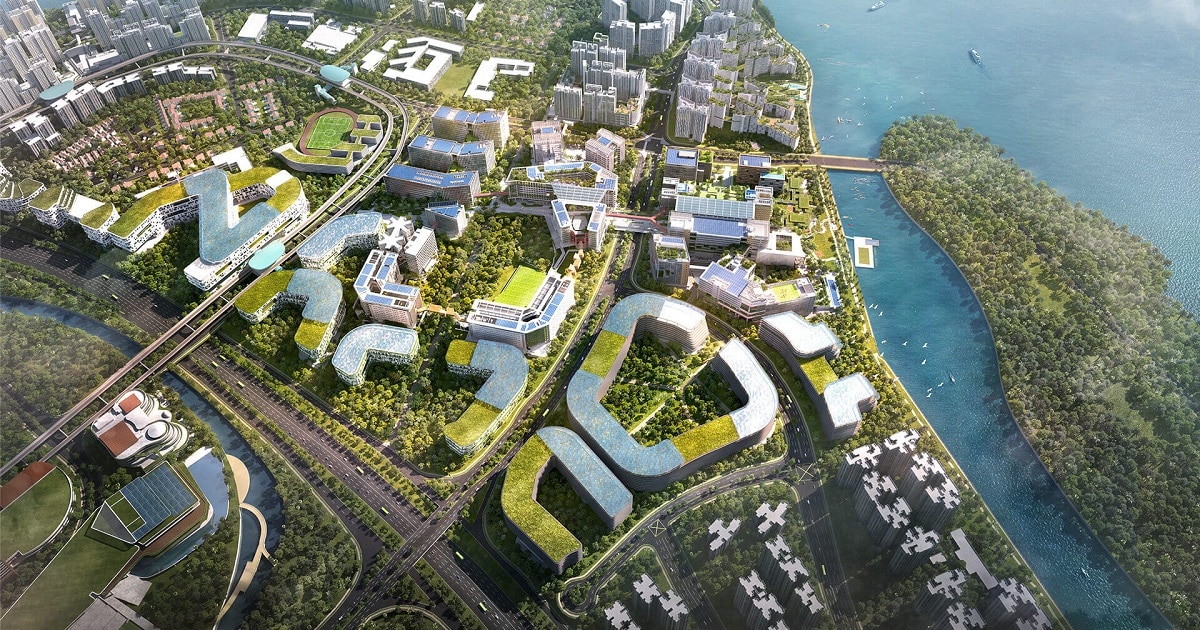
What to Know About Singapore’s Punggol Digital District
Singapore’s eagerly awaited Smart district, where innovation and digital technology open up new opportunities for a Smart society. Imagine a digital District with a business park, a university, and neighbourhood amenities conveniently next to one another. The area combines the Singapore Institute of Technology and the properties in Punggol North to create Singapore’s best.
Introduction
Singapore’s first Smart District, Punggol Digital District (PDD), is created by combining the Singapore Institute of Technology (SIT) with the JTC Business Park locations in Punggol North. PDD will be a destination for inclusive and sustainable lifestyles for the local community housing, the growth industries of the digital economy, cyber security, and digital technology. However, Punggol Smart Town, also known as the Punggol Digital District, is the SNDGO project that might be considered its most ambitious to date (after all, Singapore’s goals of becoming a nation only keep getting bigger and grander).
About Punggol digital district
Punggol Digital District, scheduled to open in 2024, brings together business, academia, government, and high-tech lifestyle in a dynamic ecosystem where students, scholars, families, and entrepreneurs may connect and materialise ideas.
“PDD will demonstrate how integrated master planning and technology can help create a more livable and sustainable environment for the community at the local district level and foster a thriving business and lifestyle ecosystem that draws talent and innovation. It is essential as Singapore moves toward becoming a Smart Nation.
The management of numerous buildings will be integrated into a single estate system using an open digital platform and data collection for these systems. Innovative minds can connect to the scaffolds and use the data to develop solutions focused on the community.
All commodities may be dropped off and picked up at the Centralised Logistics Hub, which boosts productivity and decreases traffic.
Expect space and cost savings to decrease the district’s carbon footprint with a district cooling system that centralises cooling needs.
Pneumatic Waste Collection would do away with the need for waste collection vehicles and get rid of garbage chute odours thanks to an underground vacuum-pipe network of tech associations that would cover the entire district. A smart energy grids will facilitate greater energy efficiency and savings for consumers to adopt clean energy sources for daily use (such as charging electric vehicles).
The Smart Nation and Digital Government Office (SNDGO), which reports to the Prime Minister’s Office (PMO) and is Senior Minister Teo Chee Hean, is solely responsible for planning the city-Smart state’s Nation projects and digital technology space
Business is a platform for Singaporean businesses to access government services and resources CODEX. It shares a digital platform between government agencies and the private sector E-Payments, streamlines financial transactions for the city-state and Singpass or the National Digital Identity (NDI) initiative Strategic National Projects of SNDGO. The Smart Nation Sensor Platform, a national platform that gathers data to generate solutions is simple for Singaporeans to access government services, Mobility where digital technologies are in urban transportation.
The PDD promotes inventive interaction that can result in original ideas and solutions for the community and industry. It is with an integrated master plan. The plan is to collaborate with businesses, the government, and the local community to develop a “smart” area where people can live, work, and play.
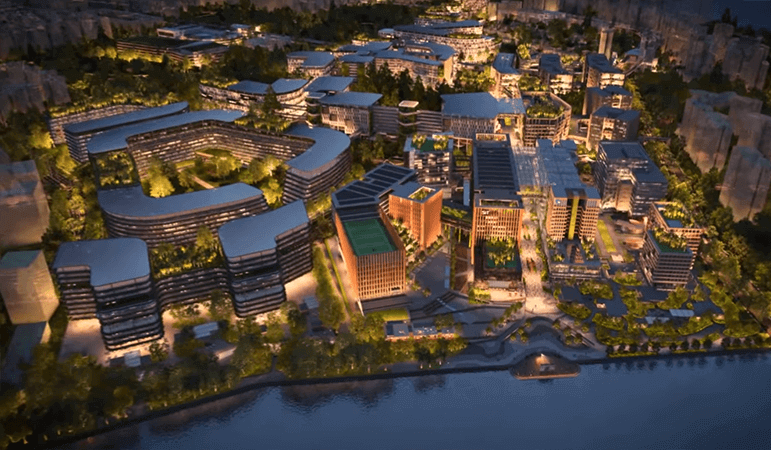
Industry and academia interact.
The Singapore Institute of Technology (SIT) is close to the buildings in the JTC business park, promoting more industry-academia contact.
This opportunities for collaboration setting aims to inspire professionals and students to seek fresh, original concepts that can be quickly prototyped, tried out, and used by firms in PDD.
Enterprise and Community
PDD will contain important enterprises and growing industries propelling the digital economy , like cybersecurity and the internet of things. The northeast region and Punggol are likely to get access to about 28,000 exciting new jobs as a result.
It’s not just about business and the economy, of course. This neighbourhood will also be home to a lively group of people. PDD will be connected to the Punggol shoreline by green linkages for the community’s recreational requirements, with shared public areas and cutting-edge community facilities.
A Smart district unlike any other is taking shape on the 50-hectare site that JTC master-planned and developed. When the digital economy gradually opens in 2024, PDD will support the implementation of cutting-edge urban solutions. PDD will also advance digital technology’s capabilities and bring together communities in a green atmosphere. Additionally, it is the mixed-use district that will generate.
The Open Digital Platform is PDD’s brain and heart.
PDD is a living laboratory where advancements in estate management, smart solutions and cybersecurity. Enabling all of these? A Digital Platform That Is Open (ODP).
The ODP was JTC, GovTech, and ST Engineering, integrating several Smart technologies, like security, autonomous delivery of commodities, and facilities management, to maximise the district’s use of energy and resources. That’s not all, though. A “digital twin” of aggregated data is possible. Companies can experiment and test-bed solutions safely and without the risks generally connected with actual trials thanks to this real-life 3D model of PDD. It makes it possible for ideas to be commercialised.
The digital twin enables the playback of historical data due to the volume of district data. Mr. James Tan, Director of JTC’S Smart District Division, “We may simulate events to improve district operations, such as traffic flow in the parking lots, or optimise cooling and lighting requirements throughout different times of the day.
The Smart district’s innovations are partnerships.
PDD wants to foster a thriving ecosystem with lots of options for collaboration. According to Mr. Tan Boon Khai, CEO of JTC, “apart from the digital infrastructure, the focus is on developing a holistic ecosystem that supports collaborative collaborations and innovation. The network is expanding to include foreign and domestic figures, ranging from a pioneer in robotics to a blockchain developer. Four renowned business leaders who will give the area credibility are Boston Dynamics, Group-IB, Wanxiang Blockchain, and Delta Electronics Int’l International (Singapore).
At the Punggol Digital District Connecting Smartness Event, Minister for Trade and Industry Gan Kim Yong was represented by Wanxiang Blockchain, dConstruct, Delta Electronics Int’l (Singapore), and Group-IB.
The network is expanding to include foreign and domestic figures, ranging from a pioneer in robotics to a blockchain expert. Four renowned business leaders who will give the area credibility are Boston Dynamics, Group-IB, Wanxiang Blockchain, and Delta Electronics International (Singapore).
Singapore’s First Enterprise District
Punggol North in Singapore would be an “enterprise district” and house digital and cyber-security businesses. Singapore’s Punggol Digital District Project has two Web Structures. The PDD has an “enterprise district, which will house the digital technology and cyber-security businesses.
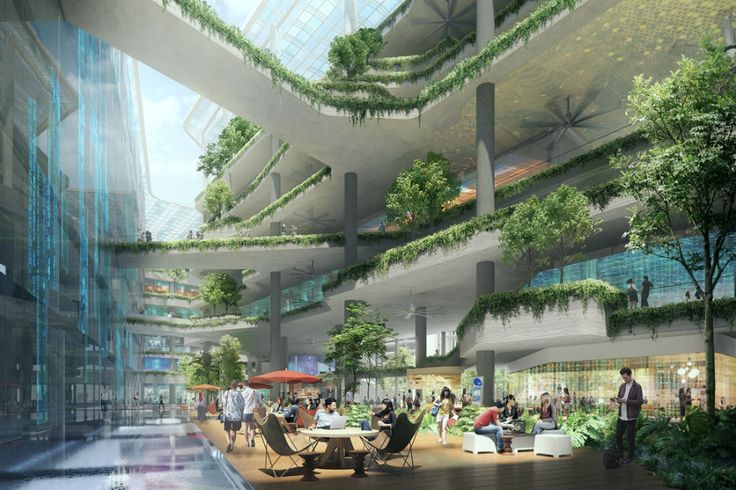
Web Director Dr. Hossein Rezai, “The unique structural problems that Punggol Digital District provides relate to the variety of end users who would profit from the project. The location will include several office buildings, a student accommodation, highly digitally oriented spaces bus interchange, a heritage trail, a complicated underground Punggol Coast MRT Station , and two stretches of connected tunnels.
It was revealed in Parliament on Tuesday, March 7, by National Development Minister Lawrence Wong, who said: “Punggol will be a crucial place for us to advance our smart nation projects… where we try out numerous novel planning concepts.”
Instead of having the Urban Redevelopment Authority impose zoning regulations, such as land use and density, on specific property parcels, JTC may optimise land use across the development and identify ways to combine the demands of various users (URA).
The new campus of the Singapore Institute of Technology is in Punggol, along with various commercial and business park sectors. We may have a closer integration of the facilities because the JTC’s business parks and the SIT campus are next to each other, according to Mr. Wong. The university might also have start-up facilities and facilities for industry research and development.
Kampong Bugis, a brand-new residential district that will be a part of MPD’s “bigger revitalization efforts” for the Kallang River, is potential. According to Mr. Wong, this will be done with consideration for the history and biodiversity of the river and will eventually breathe new life and vibrancy into the neighbourhood.
The Punggol Digital District (PDD) concept identifies the districts as the location of businesses economy’s industries. On January 21, the Singaporean government announced its debut. 2023, the district will gradually open.
The Infocomm Media Development Authority (IMDA), JTC, Singapore Institute of Technology (SIT), and Urban Redevelopment Authority all jointly launched the master plan (URA). The 50-hectare development was in URA’s draft master plan in 2013, and more information was provided by Minister of National Development Lawrence Wong last year, according to a report by Channel NewsAsia.
With the help of technical, social, and urban innovation, Punggol will grow into Singapore’s first enterprise district that combines business and education. The design of new development areas across the island is toward creating highly integrated and inclusive spaces for people to live, work, play, and learn as part of Singapore’s national goal to support long-term economic success. Additionally, each area will have a specific function in Singapore’s future economy.
Punggol, a neighbourhood in Singapore’s northeast, will grow to serve the nation-digital state’s economy. PDD, Singapore’s first Enterprise District, offers greater flexibility in the mix and scope of its land uses. The integrated planning strategy will create a business park, a university, and other community facilities in Punggol to create an inclusive and sustainable environment.
A Smart District
The Punggol Digital Neighborhood, Singapore’s first technologically advanced and environmentally friendly smart district, will be furnished with the Open Digital Platform that will permit interaction and integration among various operating systems.
An 800m-long, tree-lined campus boulevard will connect commuters to the district’s numerous locations in the Punggol Digital District.
To learn more about the technical and policy frameworks required to facilitate the adoption of new technologies, systems, and solutions, government agencies might research these initiatives, including how they work. It will advance Singapore’s development as a Smart Nation.
Other potential major players in the PDD ecosystem, besides SIT and dConstruct, have also started working on projects. Together with SIT, the cyber security company Group-IB has developed a testing of applications for new defensive systems, applications, and solutions.
Delta Electronics, a manufacturer of power components, has built a fully automated container Smart farm in the PDD Site Gallery, which showcases cutting-edge technology that might benefit businesses, among other investments. The farm has equipment for autonomous seed sowing, Smart microclimate control, environmental sensors, and other technology.
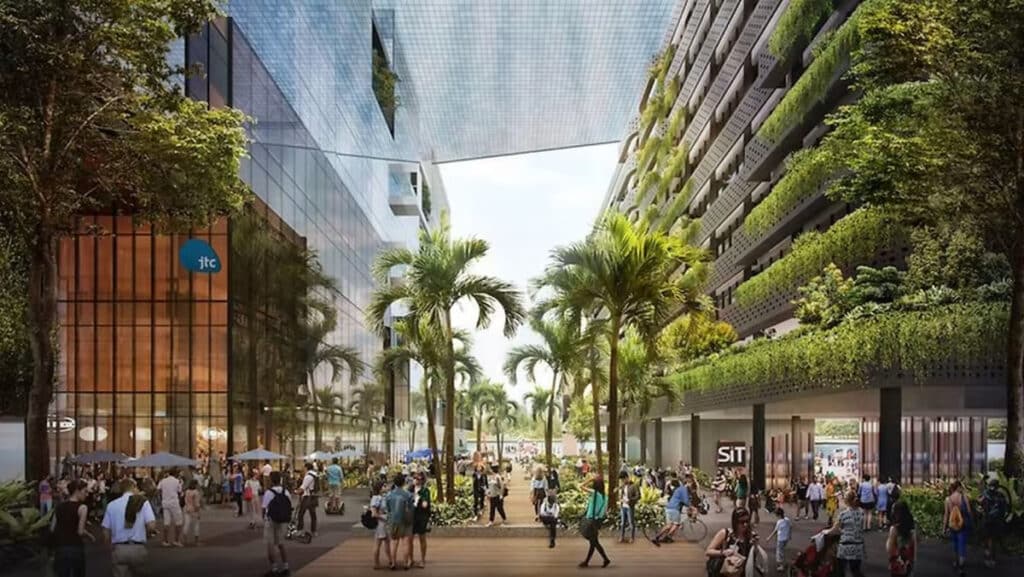
Future of intelligent cities
To build, hone, and test concepts for smart cities, businesses will find a wide range of prospective partners in the PDD. Some of the global companies that will be ecosystem partners of the district, which is to generate 28,000 employment for the digital economy, are Wanxiang Blockchain , a leader in the blockchain space in China, Group-IB, and Delta Electronics.
The PDD will also include a thriving ecosystem of organisations, including businesses, groups, academic institutions, and government entities. The Association of Information Security Professionals, Cyber Youth Singapore, and the Singapore Chapter of the Cloud Security Alliance are just a few of the many cyber security organisations concentrated here.
Because the SIT campus is nearby, businesses can use its talent to businesses The Bug Bounty Programme, created by SIT, JTC, Group-IB, the Cyber Security Agency of Singapore, and the online community Division Zero, allows SIT students to practise their hacking abilities on systems by finding flaws and vulnerabilities.
“We recognize that having a strong community with like-minded businesses and partners to engage alongside one another is crucial. Growing together to support each other’s success,” remarked Ms. Sophia Ng, director of Infocomm and media at JTC.
Building ecosystems inside our estates for businesses to collaborate alongside students, and even the general public, allowing for constant innovation, is thus a significant element of what we do at JTC.
The PDD will also feature a variety of modern and eco-friendly amenities. These consist of autonomous buses, a Smart grid that makes renewable energy and optimises electricity, a Smart parking system with an app that allows drivers to reserve parking spaces, and car plate recognition technology for entry into parking lots, among others.
Its structures will be oriented to take advantage of as much natural light and ventilation as possible. Due to its vicinity to Coney Island, a natural haven, and the former Punggol Road‘s transformation into a 1.3-kilometer-long green pathway and heritage trail, it will merge into its surroundings.
The living demonstration site for the smart living solutions in Singapore would be PDD, according to Mr. Kok Poh June, general director of JTC’s New Estates Division 2. Trials there will eventually be scaled up to other business districts in Singapore, creating the future of smart cities.
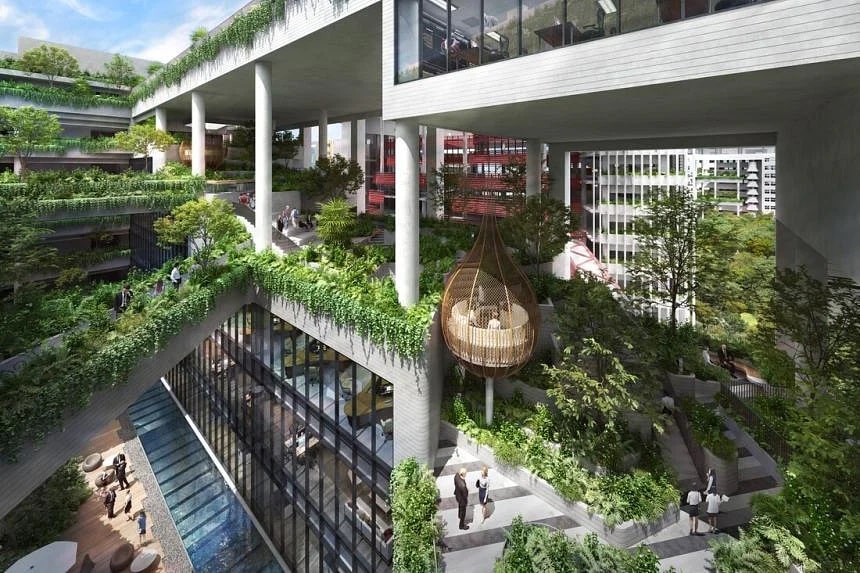
Singapore Town for the Future
Singapore is a city with lofty aspirations. The city-state has grown from its humble beginnings to become a global centre for technology, human capital, and innovation. Under visionary leadership, projects like Smart Nation Singapore attempt to encourage residents, businesses, and the government to support better living through contemporary technology. The World Economic Forum ranked Singapore’s economy as the second most competitive in the world in 2018 after the United States. The Smart City World Expo Congress also named Singapore the world’s best smart city in 2018, and it has been dubbed a technological leader in the push for the next industrial revolution.
Comfort and simplicity
Boulevard Vue The convenience is to reduce stress testing to the absolute minimum. The Lion City’s infrastructure frequently gives the impression that it is for you, from a first-rate public transportation system to a named Best in the World airport. English is one of the city’s official languages, and Singapore has a stellar reputation for safety (it has some of the lowest crime rates in the world), so the place is ready to welcome visitors from around the world. You won’t have trouble settling in at this magnificent turnkey residence, which is only a short walk from the upscale shops and restaurants on Orchard Road where Prada, Miu Miu, and Ferragamo are waiting.
Freshening Up Green Space
Singapore’s Parkroyal on Pickering hotel’s green links natural façade
Despite the nation’s scarlet flag, an aerial view reveals a metropolis covered in beautiful greenery. Singapore has concentrated on sustainable construction both inside and out, with roofs covered in trees and buildings covered in tropical flora. Since 2008, “green building” has been required in all new structures. Due to the Garden City’s small size (it covers about 278 square miles), a Saturday morning dip in the ocean can be followed by a trip to one of several breathtaking National Parks, such as the Bukit Timah Nature Reserve and the Singapore Botanic Gardens.
A Motivating Scene for Arts and Culture
Decent-quality bungalow
The influence of Malay, Chinese, Indian, and Western cultures can be seen everywhere in Malaysia, which is known as a melting pot of cultures. It is true of residential architecture, such as this modern take on a British colonial bungalow that embodies an east-meets-west style.
Take a stroll past the cheery row homes covered with ceramic tiles imported from Europe on Koon Seng Road. At one of the many nocturnal street markets, sample chicken rice or chilli crab, two of the nation’s hallmark delicacies. Explore the top-notch exhibits at several renowned art institutions. There is always culture available on the island, no matter where you are.
Singapore’s Sentosa Tanjong Beach Club
There is something for every kind of beachgoer on the island’s seven main, immaculate beaches, whether they want to set up a quiet family picnic on Palawan Beach or dance the night away at Tanjong Beach Club with the livelier set. The Johor Strait, the Singapore Strait, and the Strait of Malacca all encircle the sunny island to the north-east region and southwest, respectively.
The best waterfront living at this Sentosa Cove site is a four-story villa marina frontage and an open-roof deck with views of the Sentosa Golf Course. A waterfront cottage with an indoor/outdoor kitchen is located close by on Treasure Island, which embodies the
One of Singapore’s lowest residential densities is at Leedon Residence.
There is nothing accidental about Singapore’s journey to greatness, in contrast to how certain cities acquire their reputation as world-class cities. The city-state is outpacing the rest of the world in terms of digital innovation hub thanks to its deliberate focus and meticulous planning and execution, and it shows no signs of slowing down.
This area will also be the first in Singapore to integrate physical and digital spaces between a business park and an educational institution to foster industry-academia collaboration. The PDD would enable businesses to access “industry partners, academic expertise, as well as industry-ready talent,” according to Minister for Trade and Industry Gan Kim Yong.
Additionally, this will be the first time an integrated master plan strategy is used in Singapore to forge strategic alliances with businesses to develop PDD’s Open Digital Platform. This platform integrates city solutions into the district to transform the user and community experience. Industry partners, particularly regional SMEs, can work together to create the platform’s infrastructure and solutions.
Things you should know about Punggol Digital District
The district in Singapore will have the highest concentration of cybersecurity associations thanks to PDD’s network. It includes the Association of Information Security Professionals, Cloud Security Alliance Singapore Chapter, Centre for Strategic Cyberspace + International Studies, ISACA Singapore Chapter, and International Information System Security Certification Consortium Singapore Chapter.
To improve the workforce’s skill sets in digital technology, associations with Cyber Youth Singapore, Division Zero, and SGTech will work together to organise events, hackathons, seminars, and networking sessions.
It just takes a few steps to get to people.
Talents are essential growth catalysts. This talent pool is also readily available at PDD Smart Living Programme. It is due to the Singapore Institute of Technology’s (SIT) unusual “space swap” location. University will be situated near office buildings, creating more potential for collaboration between academics and industry.
Sharpening their knowledge and developing their abilities at the new campus will take on an exciting approach for 11,000 students and 500 academic staff members of SIT. An applied learning environment will benefit students, and businesses can readily use SIT talent to easily co-create new solutions.
At PDD, going green is now savvier.
PDD with sustainability in mind, which accounts for the design elements and techniques used in the district to maintain its clean and green status.
There has been no detail omitted. For instance, buildings are positioned to maximise wind flow and are to maximise daylight. The ODP is a grid that tracks and controls energy usage in real-time data, making it the first system of sorts for smart business district Singapore. As a result, structures within the district are 30–40% more energy efficient than similar conventional structures.
Campus Boulevard in the Punggol Digital District as depicted by an artist
The district will be home to several autonomous buses. They do not improve the district’s connection and provide cosy trips with low carbon emissions. Owners of electric vehicles (EVs) will be able to charge their vehicles at several fast charging stations around the area.
Resources are feasible to ensure longevity as well. According to Miss Sophia Ng, director of the Infocomm Media and Startup cluster at JTC, “food and horticultural waste into fertiliser, and rainwater gathered in eco-ponds will be routed for irrigation use.”
community club and connectivity are essential.
The buzz of innovation, what else can you find at PDD? Well, a lot! The business park is not just a booming centre for cutting-edge digital technology; it is to become a popular tourist attraction for locals in the Punggol neighbourhood.
According to Miss Ng, “Punggol is home to an estimated 187,800 persons, with numbers expected to climb over the next years as additional developments come to fruition and new residents and young families migrate into the town. “PDD was created with the neighbourhood in mind. It will be open all the time.”
Electronic Economy
In Punggol, JTC’s business park will serve as a home for the digital economy’s burgeoning sectors. It includes cutting-edge technology like the Internet of Things and cyber security (IoT).
This year is when construction is to start. The Punggol and the 28,000 additional jobs, These industries are grouped under PDD to generate synergy that will fuel Singapore’s economy’s digitalization.
According to a press release from the government, IMDA Assistant Chief Executive (Industry Development), Angeline Poh stated that by grouping these key growth sectors, the government hopes to build a collaborative and innovative ecosystem that will help businesses and individuals succeed in the digital economy.
New SIT campus for cooperation between business and academia
SIT’s new campus in Punggol will foster information exchange and cooperation between academics and industries thanks to the co-location of SIT research labs and educational facilities within JTC’s business park buildings. Because of the concept of Digital Punggol’s flexible land use, this space-sharing arrangement is conceivable.
For industry and personnel demands, the SIT campus will provide degree programs with a strong industry focus. The collaboration will increase students’ competitiveness and the chance to develop the skill sets needed by diverse booming digital technology companies.
Industry teaching laboratories will be established as pilot projects to support research work learning businesses that will occupy start-up space within them to build a vibrant ecosystem for the digital economy.
The first multi-energy urban micro-grid system in Southeast Asia is built in the SIT new campus thanks to a partnership between SIT and SP Group. A unified Smart network that seamlessly integrates renewable energy sources and energy storage technologies. It is an urban microgrid system. That combines gas, electricity, and thermal management solutions.
The micro-grid would be a national infrastructure accessible to Singapore’s enterprises and research community, as was revealed in October 2017. It enables the controlled testing of novel technologies while giving power to engineering students to collaborate with business partners and energy start-ups.
4 global tech firms to provide 2,000 jobs in Punggol Digital District
PDD is adding 28,000 jobs to the digital economy in high-growth fields like artificial intelligence, data analytics, solution engineers engineering, and cyber security.
The Cyber Security Agency of Singapore and other government organisations will shortly move to PDD. The PDD ecosystem aims to develop chances for collaboration in digital technology by connecting a choice for tech businesses partners.
Punggol Digital District (PDD) was in 2018 and is now under construction and is to open beginning in 2024. The new campus of the Singapore Institute of Technology (SIT), a business park, residential neighbourhoods, community centres, parks, and waterways will all be in this precinct.
With the promise of creating 2,000 employees, the first group of international businesses secured their space at PDD in July of this year, three years before their Temporary Occupation Permit (TOP). These business specialties include blockchain technology, artificial intelligence, data analysis, cybersecurity, Boston Dynamics, Delta Electronics, Group-IB, and Wanxiang Blockchain.
For instance, the Open Digital Platform, exclusive to PDF, offers tenants seamless biometric entry to facilities and visitors mobile-enabled access to their locations. The portal will be from property and building management systems to renters and academics. Additionally, before deployment, contributors can test their ideas on the platform using digital twins of the entire precinct.
Jobs in the Punggol Digital District
A lively and sustainable car-lite environment will also be present in the neighbourhood, connecting it to the larger Punggol Town and bringing jobs and social amenities closer to the locals.
Atlanta Dynamics
In 2013, Google purchased it, and in 2017, the Japanese SoftBank Group bought it. In June 2021, Hyundai Motor Group formally gained control of the business from SoftBank after an 80 percent share from the latter for roughly US$880 million in December 2020.
To enhance Singapore’s robotics innovations, the company will collaborate with SIT and the Singaporean dConstruct Technologies. Students at SIT can create robotic solutions for campus-based applications using the spot for businesses robot from Boston Dynamics and software programming tools from dConstruct.
Electronics Delta
One of the electronics companies in the world has a base in Taiwan and a founding year in 1971. Although it started operations in Singapore in 2010, it intends to establish its regional headquarters there by 2022, along with a satellite office at PDD.
The company’s solutions enable remote monitoring and data analyses of environmental and machine variables and are into PDD’s Open Digital Platform. The Delta PDD Smart Living Programme businesses to access living solutions for testing and learning includes this integration.
At the PDD Site Gallery, Delta Singapore is now constructing a fully automated container farm to display cutting-edge technology. Their container farm produces data that other nearby farmers can use because it is to the Open Data Platform.
The IT experts at Delta will test solutions, such as intelligent crowd control, lighting, and surveillance systems, in addition to providing data on agriculture.
Group-IB, This Singapore-based global threat-hunting and intelligence firm specialises in thwarting cyberattacks. It was in Moscow, Russia, in 2003, and since 2019 has been actively recruiting local talent.
Jobs in the Punggol digital district
The sheer number of professional opportunities provided by these four multinational corporations opening offices in the PDD is undoubtedly quite exciting.
Singaporeans interested in working in the digital industry have promising employment prospects at PDD over the next three years, with 28,000 new jobs to look forward to in the new precinct.











